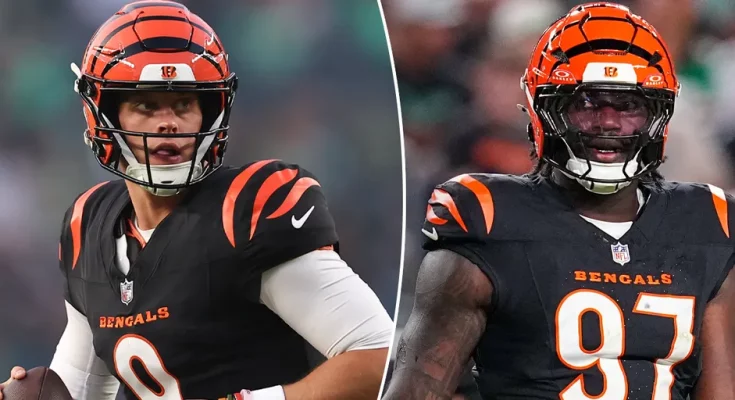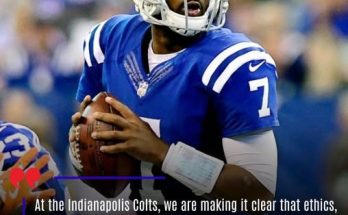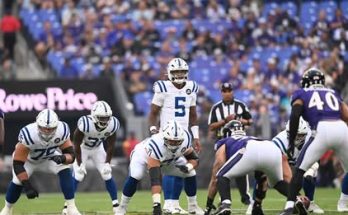Bengals training camp has always been a focal point for fans and analysts alike, offering a glimpse into the preparation, intensity, and chemistry that defines the team heading into the NFL season. This year, the intensity reached an entirely new level when a practice altercation between defensive lineman Shemar Stewart and veteran offensive lineman Lucas Patrick made headlines across sports media. The incident occurred after star quarterback Joe Burrow was bumped during a high-intensity drill, sparking a scuffle that revealed both the physical stakes of NFL preparation and the underlying tensions that can emerge in competitive environments. While on-field clashes are not uncommon in professional football, the visibility of this particular incident underscored the immense pressure that players, especially key figures like Burrow, face every day during camp.
Joe Burrow, as the centerpiece of the Bengals’ offense, naturally attracts attention. His presence in practice demands both focus and restraint from teammates, as any contact with the quarterback carries significant consequences for both safety and team dynamics. In this particular drill, Burrow was bumped—hard enough to draw immediate reactions from those around him. What might have been dismissed as a typical practice jostle escalated when Stewart, a young defensive talent known for his aggressive playing style, confronted Lucas Patrick, the seasoned offensive lineman responsible for protecting Burrow during drills. The clash that followed highlighted not only personal pride but also the high stakes of camp performance, where players vie to prove their readiness for the season ahead.
The altercation, though brief, demonstrated the intense emotions that run through NFL locker rooms. Stewart, as a rising defensive presence, is under pressure to impress coaches and establish himself as a force on the defensive front. Every contact with the quarterback—intentional or accidental—is scrutinized, and Stewart’s reaction reflected both frustration and competitive drive. Patrick, on the other hand, embodies the veteran perspective: maintaining control, enforcing accountability, and ensuring that the team operates within a framework that protects its star players. The tension between a hungry young player and a seasoned professional created a combustible situation, one that unfolded in front of coaches, teammates, and staff who had to intervene quickly to prevent escalation.
This incident also illustrates the broader dynamics of training camp, where emotions are heightened and the margin for error is minimal. Players are pushed physically and mentally to simulate the conditions of game day, often leading to friction. Protective instincts, particularly around a quarterback of Burrow’s caliber, are amplified, and minor incidents can quickly become symbolic battles over respect, hierarchy, and team cohesion. In this case, Stewart’s assertive nature collided with Patrick’s defensive responsibility, producing a highly visible confrontation that instantly became a talking point among analysts and fans alike.
In the aftermath of the scuffle, coaches and team leadership were faced with the challenge of addressing the incident while maintaining a sense of unity within the squad. Training camp confrontations are delicate situations: on one hand, they signal passion, commitment, and competitive fire; on the other, they pose risks to morale, discipline, and the overall culture of the team. For the Bengals, the key lies in channeling these moments into growth rather than division. Reports indicate that both Stewart and Patrick were counseled privately, with coaching staff emphasizing respect, communication, and situational awareness. The goal is to prevent such conflicts from spilling over into actual games, where stakes are infinitely higher.
From a strategic standpoint, this incident may serve as a lens into how the Bengals manage physicality and accountability during practices. Burrow, being one of the league’s premier quarterbacks, is a critical asset whose health must be prioritized. Offensive linemen like Patrick are tasked with creating a protective barrier, while defensive players like Stewart push the edge to simulate real-game pressure. Balancing these roles requires discipline, self-control, and mutual understanding. The scuffle underscores how quickly the balance can tip when a drill becomes more than just practice—it becomes a contest of egos, skill, and intensity.
Fans and analysts have dissected the incident extensively, debating whether it was a moment of youthful overzealousness, a lapse in veteran patience, or simply the natural outcome of a highly competitive environment. Some argue that Stewart’s reaction was a sign of his commitment to excellence and a willingness to challenge himself against top-tier opponents. Others suggest that Patrick, despite being a seasoned player, may have needed to manage his interactions with younger teammates more carefully, preventing the situation from escalating. Both interpretations highlight the complexity of team dynamics, particularly in a league where physical and mental pressures are immense and the spotlight never dims.
The media coverage surrounding the scuffle has also amplified its significance. Clips and images of the confrontation circulated rapidly across social platforms, fueling speculation about potential rifts within the team. Analysts debated the implications for team chemistry, suggesting that while isolated incidents are common in football, repeated confrontations could signal deeper issues in communication or locker room culture. However, insiders emphasize that the Bengals’ leadership is well-equipped to address such moments constructively, leveraging them as teaching points rather than sources of discord.
Beyond the immediate personalities involved, the incident touches on broader themes in professional football: the fine line between aggression and recklessness, the importance of protecting key players, and the pressures young talents face as they seek to carve out a reputation. For Stewart, this confrontation could be a formative experience, teaching him how to channel competitive energy productively while respecting team hierarchy. For Patrick, it reinforces the importance of leadership, composure, and mentoring younger teammates under high-stress conditions. Together, these dynamics contribute to the ongoing evolution of the team’s culture, with both lessons and risks embedded in each interaction.
The scuffle also serves as a reminder of how NFL training camps function as both developmental arenas and psychological tests. Players are evaluated not only on physical performance but also on emotional intelligence, resilience, and adaptability. Confrontations like the one between Stewart and Patrick test these qualities, revealing how individuals respond under pressure, how conflicts are resolved, and how teams collectively manage stress and intensity. In this sense, the incident is both a challenge and an opportunity: a chance to build cohesion, reinforce boundaries, and cultivate leadership qualities among players at all stages of their careers.
For Joe Burrow, the central figure in this drama, the incident reinforces the reality that his role as quarterback inherently involves exposure to high-stakes interactions. Every bump, hit, or miscommunication has the potential to ignite tension, emphasizing the need for him to maintain focus, composure, and leadership even in the face of chaotic moments. Burrow’s ability to navigate such situations is critical not only to his own performance but to the broader culture of accountability and trust within the Bengals organization. His response, demeanor, and interactions in the aftermath set a tone for how players approach conflict and competition throughout the season.
Looking forward, the Bengals will likely use this incident as a learning opportunity. Coaches may adjust practice protocols, emphasize communication drills, or incorporate sessions focused on emotional regulation and team dynamics. Stewart and Patrick, while involved in a fleeting clash, are positioned to emerge stronger and more aware of the delicate balance required in professional football. Their ability to reconcile, respect each other’s roles, and refocus on collective goals will be key indicators of the team’s resilience and capacity for growth.
In conclusion, the Shemar Stewart–Lucas Patrick scuffle after Joe Burrow was bumped in practice offers a compelling glimpse into the intensity, complexity, and high stakes of NFL training camps. It underscores the delicate interplay between physicality and discipline, youth and experience, aggression and control. While the incident briefly captured headlines and sparked debates among fans and analysts, its deeper significance lies in the lessons it provides for team dynamics, leadership, and professional growth. The Bengals, like all elite teams, face constant challenges in balancing competitive fire with cohesion, and moments like this serve as both cautionary tales and catalysts for development. Ultimately, the scuffle is a testament to the passion, pressure, and personality that define professional football, reminding everyone that behind every hit, every drill, and every practice, there are human stories of ambition, conflict, and growth shaping the path to the NFL season.



